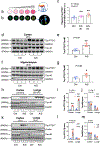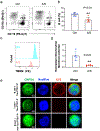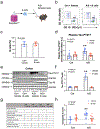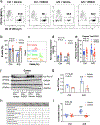Blood tau-PT217 contributes to the anesthesia/surgery-induced delirium-like behavior in aged mice
- PMID: 37249148
- PMCID: PMC10524579
- DOI: 10.1002/alz.13118
Blood tau-PT217 contributes to the anesthesia/surgery-induced delirium-like behavior in aged mice
Abstract
Introduction: Blood phosphorylated tau at threonine 217 (tau-PT217) is a newly established biomarker for Alzheimer's disease and postoperative delirium in patients. However, the mechanisms and consequences of acute changes in blood tau-PT217 remain largely unknown.
Methods: We investigated the effects of anesthesia/surgery on blood tau-PT217 in aged mice, and evaluated the associated changes in B cell populations, neuronal excitability in anterior cingulate cortex, and delirium-like behavior using positron emission tomography imaging, nanoneedle technology, flow cytometry, electrophysiology, and behavioral tests.
Results: Anesthesia/surgery induced acute increases in blood tau-PT217 via enhanced generation in the lungs and release from B cells. Tau-PT217 might cross the blood-brain barrier, increasing neuronal excitability and inducing delirium-like behavior. B cell transfer and WS635, a mitochondrial function enhancer, mitigated the anesthesia/surgery-induced changes.
Discussion: Acute increases in blood tau-PT217 may contribute to brain dysfunction and postoperative delirium. Targeting B cells or mitochondrial function may have therapeutic potential for preventing or treating these conditions.
Keywords: anesthesia; delirium; phosphorylated tau at threonine 217; surgery; tau; tau phosphorylation.
© 2023 the Alzheimer's Association.
Conflict of interest statement
Figures







Similar articles
-
Preoperative Plasma Tau-PT217 and Tau-PT181 Are Associated With Postoperative Delirium.Ann Surg. 2023 Jun 1;277(6):e1232-e1238. doi: 10.1097/SLA.0000000000005487. Epub 2022 Jul 6. Ann Surg. 2023. PMID: 35794069 Free PMC article.
-
Nanoscale imaging of pT217-tau in aged rhesus macaque entorhinal and dorsolateral prefrontal cortex: Evidence of interneuronal trafficking and early-stage neurodegeneration.Alzheimers Dement. 2024 Apr;20(4):2843-2860. doi: 10.1002/alz.13737. Epub 2024 Mar 6. Alzheimers Dement. 2024. PMID: 38445818 Free PMC article.
-
MAPT R406W increases tau T217 phosphorylation in absence of amyloid pathology.Ann Clin Transl Neurol. 2021 Sep;8(9):1817-1830. doi: 10.1002/acn3.51435. Epub 2021 Aug 2. Ann Clin Transl Neurol. 2021. PMID: 34342183 Free PMC article.
-
The Crosstalk Between Pathological Tau Phosphorylation and Mitochondrial Dysfunction as a Key to Understanding and Treating Alzheimer's Disease.Mol Neurobiol. 2020 Dec;57(12):5103-5120. doi: 10.1007/s12035-020-02084-0. Epub 2020 Aug 26. Mol Neurobiol. 2020. PMID: 32851560 Free PMC article. Review.
-
Frontal variant of Alzheimer's disease with asymmetric presentation mimicking frontotemporal dementia: Case report and literature review.Brain Behav. 2020 Mar;10(3):e01548. doi: 10.1002/brb3.1548. Epub 2020 Jan 27. Brain Behav. 2020. PMID: 31989779 Free PMC article. Review.
Cited by
-
Fibrinogen contributes to myelin deficit and cognitive impairment in aged mice after anesthesia and surgery.J Cereb Blood Flow Metab. 2025 Aug 6:271678X251338953. doi: 10.1177/0271678X251338953. Online ahead of print. J Cereb Blood Flow Metab. 2025. PMID: 40770921 Free PMC article.
-
Anesthesia-induced hippocampal-cortical hyperactivity and tau hyperphosphorylation impair remote memory retrieval in Alzheimer's disease.Alzheimers Dement. 2024 Jan;20(1):494-510. doi: 10.1002/alz.13464. Epub 2023 Sep 11. Alzheimers Dement. 2024. PMID: 37695022 Free PMC article.
-
The intersection of delirium and long-term cognition in older adults: the critical role of delirium prevention.J Neurol. 2025 May 6;272(6):381. doi: 10.1007/s00415-025-13104-1. J Neurol. 2025. PMID: 40329080 Review.
-
Microglial exosome miR-124-3p in hippocampus alleviates cognitive impairment induced by postoperative pain in elderly mice.J Cell Mol Med. 2024 Feb;28(3):e18090. doi: 10.1111/jcmm.18090. Epub 2023 Dec 23. J Cell Mol Med. 2024. PMID: 38140846 Free PMC article.
-
GLT-1 downregulation in hippocampal astrocytes induced by type 2 diabetes contributes to postoperative cognitive dysfunction in adult mice.CNS Neurosci Ther. 2024 Sep;30(9):e70024. doi: 10.1111/cns.70024. CNS Neurosci Ther. 2024. PMID: 39218798 Free PMC article.
References
-
- Vutskits L, Xie Z. Lasting impact of general anaesthesia on the brain: mechanisms and relevance. Nat Rev Neurosci. 2016;17:705–17. - PubMed
-
- Inouye SK. Delirium in older persons. N Engl J Med. 2006;354:1157–65. - PubMed
-
- Rudolph JL, Jones RN, Rasmussen LS, Silverstein JH, Inouye SK, Marcantonio ER. Independent vascular and cognitive risk factors for postoperative delirium. Am J Med. 2007;120:807–13. - PubMed
-
- Witlox J, Eurelings LS, de Jonghe JF, Kalisvaart KJ, Eikelenboom P, van Gool WA. Delirium in elderly patients and the risk of postdischarge mortality, institutionalization, and dementia: a meta-analysis. JAMA. 2010;304:443–51. - PubMed
Publication types
MeSH terms
Substances
Grants and funding
LinkOut - more resources
Full Text Sources
Medical
Molecular Biology Databases

